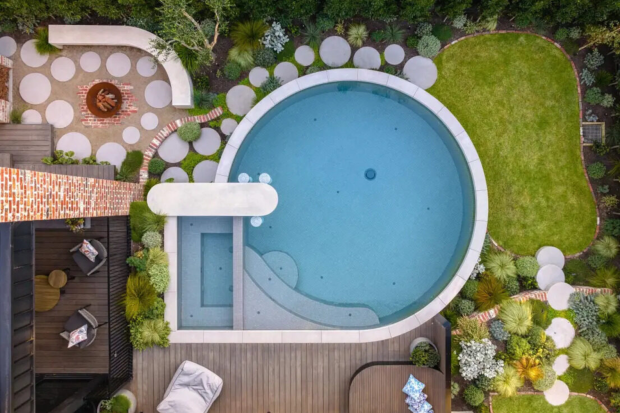Sponsored by SPASA
Cost efficiencies allowing more Aussies to make a splash
As Australians brace for a searing summer, many are looking forward to the days when it’s warm enough to get back into their backyard pool or spa and enjoy time with family and friends.
However, an increasing number of households are diving in year-round, even in the depths of winter in the colder southern states.
Water temperature is no longer such an obstacle for taking a dip, with heaters a standard accessory for swimming pools and spas sold this year, according to the Swimming Pool and Spa Association (SPASA).

Research shows Australians increasingly live in a house with a swimming pool, including in Melbourne where almost 10 per cent of residents live in a home with a pool, up from 7 per cent 15 years ago.
Chief executive Lindsay McGrath says heaters have taken Australians’ love affair with pools and spas to the next level.
“People want to swim almost all year round,” he says. “They don’t just want to swim in summer: they want to enjoy that backyard for forever and a day. No country is like ours, where people live by the water, love the water, own a pool and still go to the beach.
“It’s that natural inclination of getting into the backyard and loving the pool and spa.”
Cooler climes no issue
Australia already has among the world’s highest number of swimming pools and spas per capita, and the number of households with one is steadily rising, despite rising power and water costs.
Roy Morgan research reports one in seven people, or 14 per cent of Australians, live in a house that has a swimming pool or spa, up from 12 per cent in 2015.
Chief executive Michele Levine says Australians living in warmer climates are the most likely to have a swimming pool.
“People want to swim almost all year round . . . No country is like ours, where people live by the water, love the water, own a pool and still go to the beach. It’s that natural inclination of getting into the backyard and loving the pool and spa.”
— Lindsay McGrath, chief executive of the Swimming Pool and Spa Association (SPASA).
However, even in Melbourne, almost 10 per cent of people live in a home with a pool, up from 7 per cent 15 years ago.
Regional Queenslanders living in places such as the Gold Coast and Sunshine Coast, as well as in a string of sizeable regional coastal cities including Mackay, Townsville and Cairns top the nation with 24 per cent now owning a swimming pool or spa, up 4 percentage points from 2018.
Behind regional Queensland are the three northern-most state capitals: Brisbane (19 per cent ownership), Perth (17 per cent) and Sydney (16 per cent) – all clearly above the national rate of swimming pool or spa ownership.
“One of the best preventative steps families can take to guard against the potential hazard of drowning is to familiarise their children with water from an early age – and the home swimming pool is a key factor in introducing many youngsters to the popular activity,” says Levine.
“This is a message many Australians take to heart and our love of swimming translates into a high penetration of swimming pools and spas around the country.”

SPASA says pools and spas are becoming more water and energy efficient, making them affordable for more families.
Association guides purchases
In 2022, Commonwealth Bank of Australia’s Household Spending Intentions Index reported a 21.4 per cent increase over the year in interest in purchasing a swimming pool.
SPASA’s McGrath says pools and spas are becoming more water and energy efficient, enabling many families to reconsider the cost of purchasing one as well as other products that had been cost-prohibitive, such as pool heating.
About 30 per cent of all pools sold in Australia are bought by consumers attending SPASA’s Pool and Spa Lifestyle expos.

Swimming Pool and Spa Association (SPASA) chief executive Lindsay McGrath.
The not-for-profit trade association advocates not only for its members but the wider industry, investing profit back into its operations. As this has grown, so too has its support and services. For example, its education and training program has grown sixfold.
Last year, SPASA introduced a new trade qualification, a Certificate IV in Swimming Pool and Spa Building through its Institute of Research and Learning, which not only upskills workers but provides peace of mind to consumers that they are using a qualified installer.
Meanwhile, its Climate Care Certified (CCC) program, introduced in 2016, set new standards for efficient swimming pool and spa products, services and installations on water, and energy efficiency and sustainable design practices, as well as noise reduction.
McGrath says when households are equipped with solar panels, it further reduces energy running costs.
“We want to get our kids outdoors and teenagers away from screens, and there’s a lot that the leisure industry and the backyard industry can do to improve community and get people enjoying their backyards.”
To learn more, visit www.spasa.com.au.
Sponsored by SPASA
Introducing your Newsfeed
Follow the topics, people and companies that matter to you.
Find out moreRead More
Latest In Health & wellness
Fetching latest articles